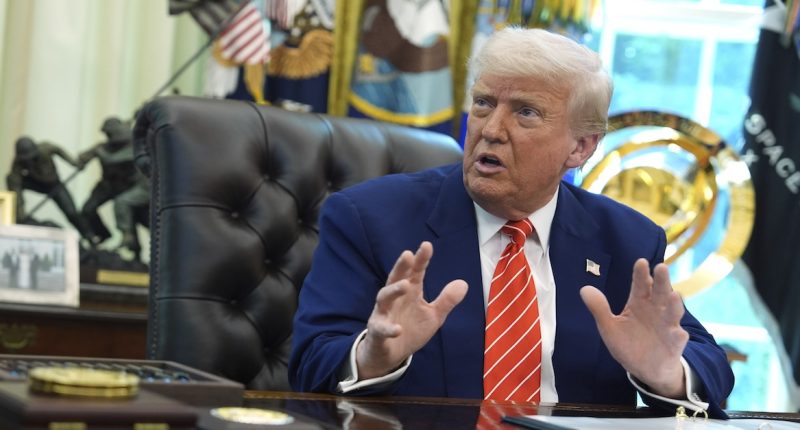Share this @internewscast.com
President Donald Trump delivers remarks during a press briefing with Elon Musk in the Oval Office of the White House, Friday, May 30, 2025, in Washington (AP Photo/Evan Vucci).
Attorneys representing the Department of Justice and Venezuelan nationals accused of belonging to the Tren de Aragua (TdA) gang engaged in a legal battle at the 5th Circuit U.S. Court of Appeals on Monday afternoon. The panel appeared receptive to the government’s stance that, should judicial review be possible, the factual bases for President Donald Trump’s Alien Enemies Act of 1798 (AEA) declaration should be approached with significant respect, akin to his justification for the federalization of the National Guard in Los Angeles.
The panel of three judges, composed of U.S. Circuit Judges Leslie Southwick, appointed by George W. Bush; Andrew Oldham, appointed by Trump; and Irma Carrillo Ramirez, appointed by Joe Biden, extended the time allocated for arguments, as W.M.M. v. Trump et al. was the sole case for the day. Southwick and Oldham were notably active in their questioning.
Southwick began with some snark, saying “this is supposed to be an emergency,” pointing out that it has been more than a month since a 7-2 U.S. Supreme Court vacated the 5th Circuit’s dismissal of a case that came to SCOTUS in a decidedly unusual and breakneck posture.
In its ruling, the Supreme Court blocked Trump’s bid for summary deportations of the Venezuelan detainees under the AEA, an 18th-century wartime law, and the detainees were “entitled to more notice than was given,” also citing its ruling in Trump v. J.G.G. from April. In the latter case, the justices declared that “AEA detainees must receive notice … that they are subject to removal under the Act … within a reasonable time and in such a manner as will allow them to actually seek habeas relief.”
Arguing on behalf of the Venezuelan men on Monday, attorney Lee Gelernt began stating his case only to be swiftly interrupted by Oldham, who asked out of the gate whether Trump’s proclamation is even judicially reviewable.
“We think that this court can give meaning to the statutory terms” of the AEA and can conclude that this statute requires military action with a foreign government or sovereign, not just a gang, Gelernt answered.
Gelernt repeatedly stated the U.S. is “not in a military conflict with Venezuela,” emphasizing that Trump’s proclamation doesn’t say that either.
“What exactly says we can second-guess the president on this?” asked Oldham.
Gelernt replied that the Supreme Court’s ruling, although not on the merits of the AEA, was proof enough that there is a judicial role to play in the lower courts in reviewing relevant statutory terms, including “invasion or predatory incursion” in the context of a “declared war.”
Under the statute, “[w]henever there is a declared war between the United States and any foreign nation or government, or any invasion or predatory incursion is perpetrated, attempted, or threatened against the territory of the United States by any foreign nation or government, and the President makes public proclamation of the event, all natives, citizens, denizens, or subjects of the hostile nation or government, being of the age of fourteen years and upward, who shall be within the United States and not actually naturalized, shall be liable to be apprehended, restrained, secured, and removed as alien enemies.”
“All we’re asking is that these terms be interpreted,” Gelernt said, arguing that the statute requirement of military conflict with a foreign government “would be the end of the matter.”
Southwick then asked what the elements of “predatory incursion” are, wondering whether historical examples of “Indian raids” or the risks of “privateers coming into our ports” during the 1798 to 1800 Quasi-War with France would fit the definition.
“It has to be an armed organized force,” Gelernt said, reiterating that the statute is “about alien enemies — when we are at war with another nation.”
“That overlays the entire statute,” he added.
Southwick followed up by saying that TdA members have been declared terrorists who are “undermining civil society by their actions.”
“I’m having a hard time drawing the line,” the judge said, noting that the administration has alleged that TdA and its members are waging “irregular warfare” within the United States.
Gelernt replied that it was “just a label thrown in the proclamation” and that the government is “not claiming we’re in armed conflict with Venezuela because they understand the implications if we were.”
“This is not a drafting error,” he said.
The attorney added that if we were at war, the Geneva Conventions would kick in and the military could be ordered to shoot TdA members.
“We don’t generally treat gangs like this,” Gelernt remarked.
Oldham next asked Gelernt to cite a Supreme Court case, if there was one, that says a “court can countermand the president in declaring that we are in an armed conflict.”
“I don’t have a case like you’re asking for,” Gelernt said, again saying that the government itself is not declaring a military conflict.
Love true crime? Sign up for our newsletter, The Law&Crime Docket, to get the latest real-life crime stories delivered right to your inbox.
“Can we say no, that’s not military, and that’s not the sort of stuff the AEA allows?” Oldham pressed.
Gelernt answered that if the statute is reviewable, then the court can say no.
After the extended back-and-forth on judicial review, Southwick asked Gelernt about the issue of notice and what SCOTUS meant by it.
Gelernt said that seven days’ notice was too short, since it is difficult to reach detainees and difficult for them to find lawyers who can handle the complexities of habeas corpus cases. Gelernt said that a 30-day notice would be more workable and that said notice should be served on the detainees’ counsel or immigration lawyer.
“It has to be meaningful notice to actually file a habeas petition,” the lawyer said, noting the government was citing a “very serious statute with sweeping powers only to be used in wartime.”
Arguing for the Trump administration was Drew Ensign, a deputy assistant attorney general in the civil division of the DOJ.
Ensign defended Trump’s proclamation as “plainly a lawful exercise” of his executive authority, for which the president is due great “deference.”
Ensign stated that the DOJ’s “frontline position” is that the president’s determination that the factual predicates of the AEA have been met isn’t something reviewable by the courts.
Southwick, commenting that “there are things that maybe get reviewed under the AEA” given the aforementioned SCOTUS rulings, pressed for more on the administration’s facts.
“This is not an ordinary criminal gang,” Ensign said, stating that TdA gang members are present in at least 40 states in the country and that the government has established that they have “taken over entire apartment buildings.”
After the DOJ attorney said the government thinks that it meets the “predatory incursion” or “invasion” language in the AEA, he pointed to an FBI report that TdA may try to assassinate critics of Venezuelan President Nicolás Maduro in America.
“TdA is tightly bound up with the Maduro regime,” Ensign said, calling TdA a “proxy of the Venezuelan government.”
When Ensign was asked to address the issue of reasonable notice and access to lawyers, he stated that everyone who previously filed habeas cases had done so within 72 hours.
It was at this point that Judge Ramirez spoke for the first time: Didn’t those individuals already have immigration lawyers? And what about those who don’t have counsel?
Ensign answered that those without lawyers are provided with a list of attorneys “upon request.”
On rebuttal, Gelernt said it was difficult to persuasively say that a military conflict is afoot if the administration itself won’t say so, and he downplayed the FBI’s take on the TdA’s nexus to Maduro as a “medium-confidence” report.
Oldham then asked the attorney a hypothetical question about whether a Trump invocation of the AEA would be reviewable if the proclamation were made in response to an Iranian cleric issuing a “fatwa” against Trump.
What if, Oldham asked, Iranian “sleeper cells were activated” in the U.S. in response to the fatwa?
Gelernt responded that the proclamation would have to name Iran, just as the TdA proclamation had to name Venezuela.
“This [statute] has been invoked only three times in a major, major war,” he said, noting that the U.S. didn’t invoke the AEA to deal with the mafia decades ago based on ties to Italy and Sicily.
Criticizing the proclamation’s “fuzzy language” about “coordinated destructive activity,” terminology that could apply to many things, Gelernt concluded that past invocations of AEA named countries, and then a subset of individuals were flagged for removal.















